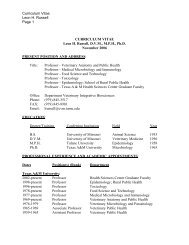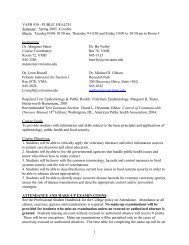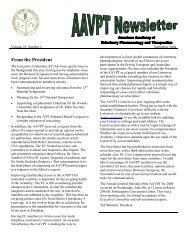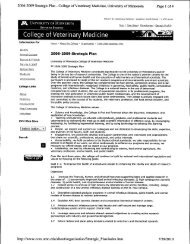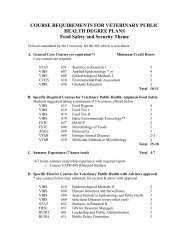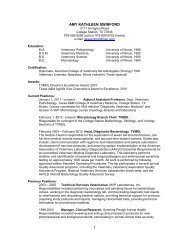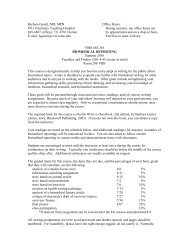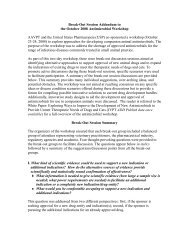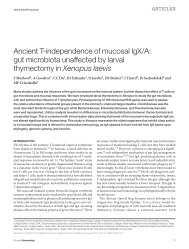Disaster - College of Veterinary Medicine - Texas A&M University
Disaster - College of Veterinary Medicine - Texas A&M University
Disaster - College of Veterinary Medicine - Texas A&M University
Create successful ePaper yourself
Turn your PDF publications into a flip-book with our unique Google optimized e-Paper software.
an emergency blood donation. Not all emergencies arise<br />
from disaster, and not all patients needing blood arrive<br />
from a disaster zone. In fact, most are pets that have become<br />
critically ill. The blood bank is there to provide a needed<br />
resource that gives these pets a second shot at life.<br />
“It’s important to have a supply <strong>of</strong> different blood components<br />
available at all times because we are both a primary<br />
emergency facility and a large referral facility,” explains<br />
Mary Radcliffe, blood bank coordinator <strong>of</strong> the VMTH’s<br />
Small Animal Hospital ICU. “We see high risk, critical cases<br />
which <strong>of</strong>ten require immediate treatment. These types <strong>of</strong><br />
patients may not even survive a 24–48 hour delay in receiving<br />
a particular component.”<br />
Radcliffe explains that<br />
there is a greater need for<br />
animal blood banks in<br />
today’s veterinary ICUs than<br />
there was about 10 to 15 years<br />
ago. In the past, most animals<br />
would only have about<br />
one surgery in their lifetime.<br />
Today, animals will average<br />
about two to three major<br />
surgeries or medical issues<br />
in their lifetime due to the<br />
increased owner care and the<br />
stronger social role that pets<br />
play in society.<br />
Volunteer blood donors<br />
are crucial to the supply the<br />
clinic has on hand. Privately<br />
owned dogs and cats serve as<br />
blood donors, and a friendly<br />
personality is a must.<br />
“I have been in veterinary<br />
medicine for 10 years and I<br />
have always allowed my dogs<br />
to be blood donors,” said<br />
Paula Plummer, veterinary<br />
technician at CVM. “People<br />
do not realize that blood<br />
banks are just as important in<br />
veterinary medicine as they<br />
are in human medicine. I<br />
allow my dog to be involved<br />
because it truly is an amazing<br />
feeling to know that she helped save another dog’s life.”<br />
Both dogs and cats must be between one and six years<br />
<strong>of</strong> age, spayed or neutered, and in good health. Cats must<br />
weigh at least 12 lbs. and dogs must weigh at least 55 lbs.<br />
Many blood banks have several Greyhounds and Pit<br />
Bulls in their donor programs due to the relatively higher<br />
incidence <strong>of</strong> the universal blood type in these breeds, as<br />
well as their easygoing nature, which works best during the<br />
donation.<br />
There are multiple blood types in dogs, but there are<br />
universal donors who can generally donate to any dog in<br />
need. The technicians at the VMTH make sure to routinely<br />
perform a crossmatch on canine patients to rule out any<br />
incompatibility as a result <strong>of</strong> a previous transfusion.<br />
D’Lisa Ryland collects blood<br />
while Paula Plummer holds Maddie.<br />
Universal donors do not exist in cats as they have three<br />
different blood types: A, B, and AB. The most common<br />
blood type is A. The feline patients must be typed and transfused<br />
with their identical blood types as the need arises.<br />
Most type A cats are domestic short hair mixed breeds, while<br />
there is a higher incidence <strong>of</strong> the rarer type B and AB in<br />
some <strong>of</strong> the purebred cats.<br />
“Before accepting a dog or cat into the program they are<br />
blood typed and then if they are suitable, they come in to<br />
the clinic for a complete physical examination and blood<br />
draw to rule out any medical problems,” states Radcliffe.<br />
“They remain in the program for approximately two years<br />
and may donate once every three months.”<br />
Right now there are 12<br />
dogs and one cat that participate<br />
in the program. All<br />
typing, testing, annual physical<br />
exams, and vaccinations<br />
for the donors are done at no<br />
charge to the owner.<br />
Radcliffe notes that if<br />
necessary they can purchase<br />
blood from a commercial<br />
blood bank for exotic<br />
animals.<br />
“Between the commercial<br />
blood bank supplies,<br />
which we purchase, and our<br />
volunteer donors, we generally<br />
manage to cover our<br />
blood needs. Holidays and<br />
times <strong>of</strong> natural disasters are<br />
always a particular concern.<br />
This is due to the increased<br />
case load, as so many other<br />
facilities are closed,” remarks<br />
Radcliffe.<br />
While the majority <strong>of</strong> the<br />
blood bank program’s needs<br />
are currently being met,<br />
many <strong>of</strong> the donors’ owners<br />
are students who graduate<br />
and move away with their<br />
pets. Also, as pets get older,<br />
they may have to “retire”<br />
from the program based on<br />
age, or they may develop medical problems unrelated to being<br />
a donor that may force them into “early retirement.”<br />
“I am always accepting new applications for the program,”<br />
states Radcliffe. “Interested people in the Bryan/<strong>College</strong><br />
Station area can contact me by email at mradcliffe@cvm.tamu.<br />
edu.”<br />
“Our cases range widely considering the injury,” said<br />
Radcliffe. “We provide a service that can help save lives for<br />
animals every day. Whether we help to save their lives long<br />
term, or just extend them so their owners can have a time to<br />
say goodbye and get closure, we realize that this is a necessary<br />
service in veterinary medicine and we are grateful for<br />
the opportunity to provide it.”<br />
CVM Today • Summer 2010 • 7




